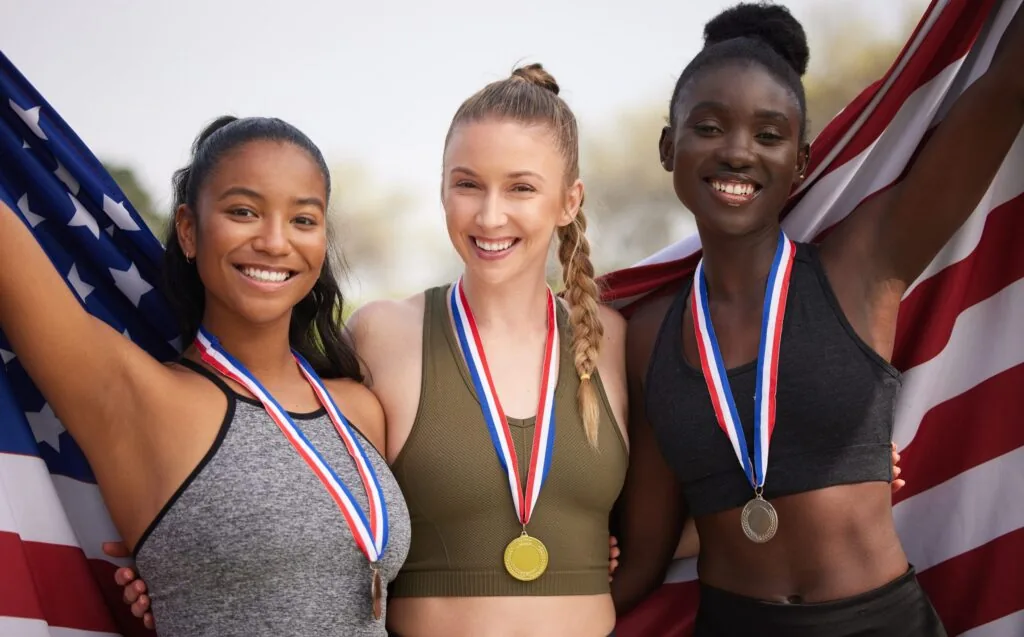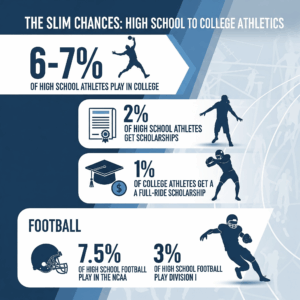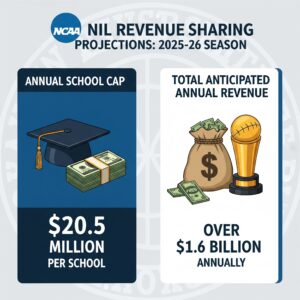As a parent, you’ve spent years cheering from the sidelines, driving to practices, and watching your student-athlete pour their heart into their sport. Now, as college looms on the horizon, you’re navigating the complex world of college athletics. It’s a journey filled with hopes, dreams, and a lot of questions. Here’s a guide to help you understand the landscape and make informed decisions.
The Reality of College Athletics
First, let’s look at the numbers. It’s important to have a realistic perspective on the opportunities available.
- How many high school athletes go on to compete in college? Only about 6% to 7% of high school athletes continue to play sports at the college level, including all divisions of the NCAA, NAIA, and junior colleges.
- How many receive athletic scholarships? The percentage of high school athletes who receive an athletic scholarship is even smaller—around 2%. And of all college athletes, only about 1% receive a “full-ride” scholarship. Most athletic scholarships are partial, meaning they only cover a portion of the tuition and other costs.
- What about football players? While football is a prominent sport, the odds are still very low. Approximately 7.5% of high school football players go on to play in the NCAA. And of those, only about 3% go on to play at the Division I level.
If you have a student athlete that is legitimately in the top 1% that can garner an athletic scholarship, good for you. For the rest of you hoping that your son or daughter will get an athletic scholarship, the numbers don’t lie. HOPE IS NOT A STRATEGY!
Athletic Scholarships: A Breakdown by Division
A key factor in the college search is understanding how scholarships work across the different NCAA divisions.
- Division I (DI): These schools, which generally have the largest student bodies and athletic budgets, can offer athletic scholarships. It’s also worth noting that some Division I schools, like those in the Ivy League, do not offer athletic scholarships.
- Division II (DII): Division II schools can also offer athletic scholarships. They are known for providing a balance between high-level competition, academic achievement, and community service.
- Division III (DIII): This is a crucial distinction: Division III schools do not offer athletic scholarships. However, DIII student-athletes often receive a significant amount of financial aid through need-based and merit-based grants and scholarships. In fact, more than 80% of DIII student-athletes receive some form of non-athletic financial aid. Athletes at these smaller schools are a vital part of the campus community and have shown to have higher graduation rates, making them a valuable part of the student body.
Understanding Name, Image, and Likeness (NIL)
The introduction of Name, Image, and Likeness (NIL) has been a significant change in the world of college sports. An Here’s what you need to know.
- What is NIL? NIL allows student-athletes to be compensated for the use of their name, image, and likeness. This can include everything from endorsement deals and social media promotions to personal appearances and autograph signings. It has transformed college athletes from “amateurs” into entrepreneurs, giving them the ability to build their own brand and earn income while in school.
- How does it affect the college athlete? NIL gives athletes agency over their personal brand and a new way to earn money. This can help alleviate some of the financial strains many student-athletes face, and it provides a valuable opportunity to develop business and marketing skills.
Based on the “House v. NCAA” settlement, which was approved in June 2025, there are new rules regarding how schools can compensate student-athletes.1
Here’s a breakdown of the key points for the 2025-26 academic year:
- Annual Amount Per College (Revenue Sharing): Colleges that opt into the settlement can share up to $20.5 million in revenue with their athletes.2 This payment is in addition to traditional scholarships and existing third-party NIL deals. This cap is expected to increase annually, potentially reaching around $33 million per school over the next decade.
- Total Anticipated Amount of Money: While the exact total amount is not yet finalized, estimates suggest that NCAA Division I schools could be paying out over $1.6 billion annually in revenue sharing starting in 2025. This figure is based on calculations that many of the Power Conference schools will opt to pay the full $20.5 million allowed.
It’s important to distinguish between these direct school payments and traditional Name, Image, Likeness (NIL) deals. The $20.5 million cap is for direct payments from the school, which are separate from NIL deals that athletes secure with third-party companies or collectives. However, all third-party NIL deals over $600 must now be reported to a new clearinghouse called NIL Go to ensure they are at fair market value and not disguised as recruiting inducements.
- What are the rules for Traditional NIL agreements not paid directly by the school? The rules for NIL are complex and can vary by state and university. It’s a decentralized system with a few key principles:
- Not a salary: NIL is not a salary paid by the school for an athlete’s performance. The school itself cannot be directly affiliated with the NIL deal.
- Disclosure is key: Athletes are now required to disclose their NIL deals to their university.
- Recruiting prohibitions: Deals cannot be used as a direct inducement to recruit a prospective student-athlete to attend a particular school.
- State laws: You must be mindful of the laws in the state where your student-athlete’s college is located, as some states have prohibitions on deals with certain industries like alcohol or gambling.
The Role of Parents and Professional Advice
While NIL gives the student-athlete the right to monetize their brand, parents still have a vital role to play.
- Parents as a support system: You are your child’s primary support system. You can help them understand the opportunities, vet potential deals, and ensure they are making sound decisions.
- Student-athlete’s rights: It’s the student-athlete who owns the rights to their own NIL, and they are the one who enters into the agreements. However, as with any major life decision, the involvement and guidance of a parent is invaluable.
- Should NIL athletes seek professional advice? Yes. NIL deals can be complex business and legal agreements. Many athletes and their families lack the expertise to navigate these deals, understand the tax implications, or manage the new income. Seeking professional advice from a financial advisor or an attorney with experience in NIL is highly recommended. These professionals can help with:
- Tax planning: Understanding and preparing for the taxes that will be owed on NIL income.
- Contract review: Ensuring the terms of a deal are fair and protect the athlete’s interests.
- Budgeting and investment: Creating a plan for managing and growing the income they earn.
- Branding: Helping them build a sustainable personal brand that extends beyond their college career.
The journey to college athletics is a rewarding one, and with the right information and a strong support system, your student-athlete can navigate the new landscape of college sports with confidence and success.
Based on the information I found, here are the sources used to compile the details about NIL revenue sharing for the 2025-26 academic year.
- College athletes will be paid after House v. NCAA settlement: NIL changes, enforcement, contracts and more – CBSSports.com
- NCAA Revenue Sharing & NIL Estimates 2025 – nil-ncaa.com
- What the NCAA Settlement Means for Colleges and State Legislatures – ncsl.org
- Brief on House v. NCAA Settlement (February 12, 2025) – Knight Commission on Intercollegiate Athletics
- House v. NCAA Settlement Approved: Era of Direct Payments to College Athletes HowBegins – ropesgray.com
- The Hidden Costs of NIL: How Injuries and Insurance Impact Athlete Earnings – sportsmed.org
If you want to talk more about getting your student-athlete in and through college, please feel free to schedule a complimentary meeting with me. In the meantime, you can also receive your free College Money Report™ to see how much financial aid your student will be eligible for.





